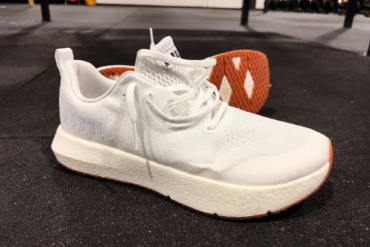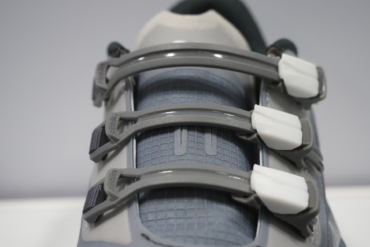SCARPA launched the first version of the Mago in 2007. It was a niche performance shoe designed by longtime shoe designer Heinz Mariacher that introduced a novel X-Rand system for foot support.
Banana-shaped and radically down-cambered, the Mago is built for a specific usage: grabbing, hooking, scumming, and toeing in on the steeps. It has a supportive shank (the Toe Power Support, or TPS, insert) under the toebox for a dash of edging stability. This feature has stayed through the shoe’s second and now third iterations. I’ve climbed in all of them.
I still have my original pair and break them out occasionally for bouldering and radically overhanging climbs. And I loved the second version, which came out in 2018. I punished them on a project at the Dungeon, a 30-degree overhanging swell of granite in South Platte, Colo. But they were also precise and versatile enough for thin, vertical face climbing.
Version 2.0 had an XS Edge sole, which did well on techy terrain. But the midsole got soft, the uppers stretched, and the shoes lost their “bite.” I relegated them to bouldering shoes, where softness reigns supreme, and eventually sold them with a small tear in my eye.
When I learned that Mariacher had returned to the drawing table with the 2022 Mago, I was stoked. I’ve always loved the Mago and was excited to see the revisions. However, the big questions were: What had changed? How well would these puppies hold up?
The 2022 SCARPA Mago: So, What’s New?
Before we get to the testing, a few notes, via SCARPA, on important updates:
- The Mago’s patterning, materials, and rubber placement are all different — the shoe is designed to be more flexible, malleable, and perform better. For example, the X-Rand on the medial side now has three perforations in the front of the shoe and three perforations along the arch for stretch.
- The upper now uses dual-layer perforated microsuede to improve the shoe’s dynamic properties. The previous microsuede upper was not perforated.
- The toe-scumming patch now has full M50 rubber, SCARPA’s softest compound.
- The heel has three significant updates:
- 1) It’s been redesigned with SoftSpine Heel construction, a thin I-beam of rubber that runs the entire length of the heel, paired with thinner, perforated rubber on the sides.
- 2) A Soft Touch fabric heel pocket provides a soft feel inside and increases footbed friction for hooking and fit.
- 3) Pressure Absorbing Fit (PAF) technology — also found on other SCARPA models — uses softer material between the two rubber rands on the Achilles to reduce pressure on the tendon.
- The new perforated tongue is more breathable and comfortable.
- The big-toe pocket lining is Alcantara leather, a soft, velvety material used on the Furia Air and Boostic to improve footbed grip.
- The outsole is 3.5 mm XS Grip 2 versus the stiffer XS Edge used on the previous version.
- One thing that has not changed but is worth noting (and is crucial to the Mago’s performance) is the TPS (toe power support) insert; this is a small, specially shaped underfoot insert under the forefoot. It provides minimal but focused support, keeping the shoe flexible but supporting when you have to stand on your feet. This allows the Mago to have a powerful toe for standing on tiny holds, but not at the expense of underfoot flexibility and the ability to grab at features on steep terrain.
Sizing, Comfort, Lacing of the SCARPA Mago

I’ve been testing in two different sizes, 42 and 41.5. I’m a street-shoe size 10 and typically wear 41 in La Sportiva and SCARPA (the Instinct line). But for the more asymmetrical Magos, Boosters, and Boostics, I hover between 41.5 and 42. I have wide, high-volume feet, so banana shoes like the Magos don’t usually work at 41. There’s way too much torque on my feet.
Out of the box, I noticed with both sizes how comfortable the footbed was for such a high-octane shoe. This meant fewer “I need to whip these off the minute I hit the chains” panic moments.
The interior was surprisingly supple, like sinking into a plush leather seat in a Ferrari when expecting a plastic bucket seat. The microfiber (synthetic leather) was cushiony, and the heel cup didn’t pinch. Also, the stitching between panels was so tight and refined that I never felt it underfoot.
My friend Bo, who had just bought a pair, said, “The Mago’s build feels super deluxe and plush and fits like a kid glove.” At both sizes 42 and 41.5, I got that reassuring whooshing sound when putting them on — a bespoke fit.
I’ve primarily been using the 42s for comfort, but even at this more forgiving size, there was still play in the laces to crank the fit down for redpoints. But then I keep it looser for bouldering and onsights.
That said, for max redpoint precision (read: not bouldering; hitting the pads in tight banana shoes is a horror) and to get my big toe over the TPS insert, I sized down. Not so far my heel couldn’t drop into the heel pocket, though. I didn’t want a baggy spot, especially with the Mago’s softer, more flexible redesign, which relied on skin-to-shoe contact.
Grabbing, Standing, Hooking, and Scumming
Overhanging rock forces different movement than vertical terrain. Instead of keeping my feet under me, driving through my toes to ticktack up, I often look to use my feet like a tail. I kick them out to the sides to find the most significant footholds possible, in whatever whacky configuration, and traction my hips into the wall.
This is something the new Mago did brilliantly and for which they’re built with their radical asymmetry. Because of that banana curve, I could place my foot well to the side, as high as my flexibility allowed, and still power through the big toe. I repeatedly confirmed this on über-steep granite around the Front Range of Colorado.
On a cavy, cracky lieback route at my friend’s secret crag, I could post up on smears way out to the side and lock in. Ditto on the 5.13b “The Event Horizon” in Staunton State Park, with its strange, traversing crux involving hooks, edging, and smears to cross a polished lithic wave.

Does the New Mago Grab Better Than Its Predecessor?
I believe so. The XS Grip 2 sole was stickier. And the TPS insert, or at least the overall build of the toebox, felt stiffer and more stable than the last version.
It’s held up much better to wear, meaning the shoes have retained their grabbing bite. After months of testing, I have yet to note the dreaded squishiness I got with version 2.0 that crept in after a month.
They also seemed a bit less down-cambered. This gave them a more comprehensive range and more fluency than the last two versions on gently overhanging climbs.
I also got a ton of feedback, even with the TPS insert, and found the Mago to be incredibly stable on tiny footholds on overhanging rock. The insert was the only stiff part of the shoe. The rest is built for flex and sensitivity and was excellent for feeling and digging into micro-holds.
My buddy Bo noted, “The SCARPA Mago is a lot softer than both the Boostic and Miura, but something about the shape and lacing and relatively stiff forefoot does seem magical to combine edging performance with amazing sensitivity and comfort.” Essentially, my forefoot stayed locked and rigid while the rest of the shoe flexed — it’s a cool concept.
In the eternal battle between softness and rigidity/precision, the flipside was that these were no Instinct VS. If you’re looking for a pointy, hyper-precise, full-support, micro-edging monster, look elsewhere. Plus, the Mago has a blunt, rounded toe that was great for grabbing and smearing. But it wasn’t ideal for sustained vertical edging or thin pockets.
This much I found out on “Give the Dog a Bone” (5.13a) in Boulder Canyon. The Mago flexed more than I was comfortable with on the granite potato-chip feet of this slabby face-and-seam route. Yes, I was still on the footholds, but the performance was only adequate. It was enough to get me up a mandatory slab at the top of a big cave, but vert and slab weren’t the Mago’s thing.
However, it would be interesting to see if I could get better edging support and precision from an XS Edge resole. Perhaps this would bring the performance closer to the previous version on slabbier climbs.
But Back to the Steeps!
The Mago went full beast mode for hooking and scumming: 9/10 here. The heel may have initially felt “too squishy” for me. I’m used to the rigid, protruding heel cup of, say, the Solution. But I’ve come to love the pared-down PAF heels SCARPA has been using lately.
With the Mago’s softer heel design, I got mad feedback. Plus, it kept the build lighter and added versatility to the creative beta solutions mandated by steep stone.
On The Event Horizon, there is a high right heel I have to place just so on a sloping plaque and then rock over. I could feel every last rugosity in the granite. Meanwhile, the rubber “mohawk” of the SoftSpine Heel dug hard into the hold, and there was no slippage. None.
Scumming was aces, too, as I found out on a cave climb with a hand-foot toe scum match to surmount a horizontal roof. The M50 rubber deformed perfectly into the hold to lock me in.
Conclusion
I liked the new SCARPA Mago more than its predecessors. They embraced their niche as a steep-rock specialist more fully, going all in on the genre with a softer, more flexible build that’s retained good edging bite.
They were wicked comfortable inside the footbed for such high-performing shoes. And they have held up better — way better. I’m still getting solid edging and grabbing performance, with no decline even as the outsole wears.
I’m a little bummed that the new SCARPA Mago wasn’t as precise and supportive on techy faces as version 2.0. I believe one can rectify this with a stiffer compound on the outsole. Maybe I’m more of an XS Edge guy regardless of the shoes.
The Mago excelled on steep terrain as well as overhanging plastic. Size up for a bouldering and onsight fit; size down and keep ’em pristine for your hardest overhanging redpoints in the Red River Gorge or the Wicked Cave at Rifle.
The redesign is also visually exciting, with its midnight-black and neon-green motif. And SCARPA solidly crafted the shoe — I’m sure they’ll hold up to multiple resoles, justifying the $209 cash outlay.
SCARPA Mago: Version 3.0 Stats
- Comfort: 10/10
- Grabbing: 10/10
- Edging: 7/10
- Smearing: 10/10
- Hooking: 9/10
- Scumming: 9/10
- Longevity: 9/10
- Aesthetics: 10/10







